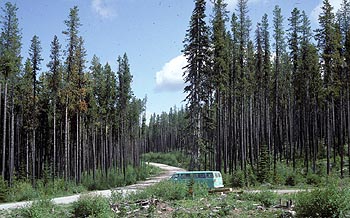Lodgepole Pine

Common Name(s):
Lodgepole Pine
Scientific Name:
Pinus contorta Dougl.
Scientific Name Synonyms:
None known
Symbol:
PICO
Description:
Life Span: Perennial
Origin: Native
Season: Evergreen
Growth Characteristics: Lodgepole pine is known for its long, slender trunk and high, thin crown. The average mature size is 24 inches in diameter and 70 feet high, although trees only 5 inches in diameter are often 50 feet high.
Flowers/Inflorescence: Both male and female cones are found on the same tree, but are separate. The male cones are in large, orange-red clusters. The seed cones (female cones), are yellow-brown in color, average about 1 ½ inches in length. The tips of the cone scales near the cone apex are armed with sharp prickles, while the tips of the basal scales are usually knoblike. Cones are larger on one side near the base (asymmetrical). They frequently cling to the twigs in a closed condition for several years, a condition described as "serotinous."
Fruits/Seeds: Small, thin-shelled seeds, about 1/16 inch in length with terminal wings ½ inch long. Cones require heat to melt resin and release seeds, or fire kills the tree and prevents water from reaching the cones.
Leaves: Needle-like in bundles of two. These leaves vary in color between yellow-green and dark green. They average 2 inches in length and are usually twisted, hence the scientific name contorta. Buds are resinous, dark brown in color, and about ¼ inch long.
Stems: Twigs are stout and dark in color, thickly covered with leaves that remain on the twigs for about 5 years. Bark is very thin, rarely exceeding ½ inch, which tends to reduce the tree's resistance to fire. The bark is generally not rigid, but scaly. The scales are brown to gray and loosely attached. The wood is rather hard, brittle, and straight grained.
Ecological Adaptions:
Lodgepole pine is adapted to high mountain slopes at elevations usually above 6,000 feet. Reproduction is best attained in areas that have been cleared either by man's activity or as a result of fire.
Rocky Mountain lodgepole pine produces serotinous cones which do not open at maturity because they are sealed shut by a resinous bond between the cone scales. These cones remain on the tree for years and require temperatures between 113 and 140 degrees F (45-60 C) to melt the resin and release the seed. In nature, only forest fires generate temperatures of this magnitude within a tree's crown.
Soils: Lodgepole pine grows on a wide variety soils but grows best on moist, medium-textured soils derived from granitic, shale, or coarse-grained lava parent materials.
Associated Species: Pinegrass, elk sedge, serviceberry, curlleaf mountain mahogany.
Uses and Management:
Utah's best stands of lodgepole pine are found on the slopes of the Uinta Mountains. These stands were heavily cut in early railroad days for cross ties. Many trees are also used for mine timbers, poles for buildings and fences. Today these trees are extensively used for pine lumber and other mill products.
Lodgepole pine's importance to big game animals is as cover and habitat. Lodgepole forests cover extensive areas that serve as deer and elk summer ranges. Although these forests typically have sparse understories and provide very little forage, they provide important cover for ungulates that forage in associated nonforested communities.
Native Americans used the straight and slender poles to support their lodges. They also ate the cambium for food and occasionally used the sap for medicinal purposes.

